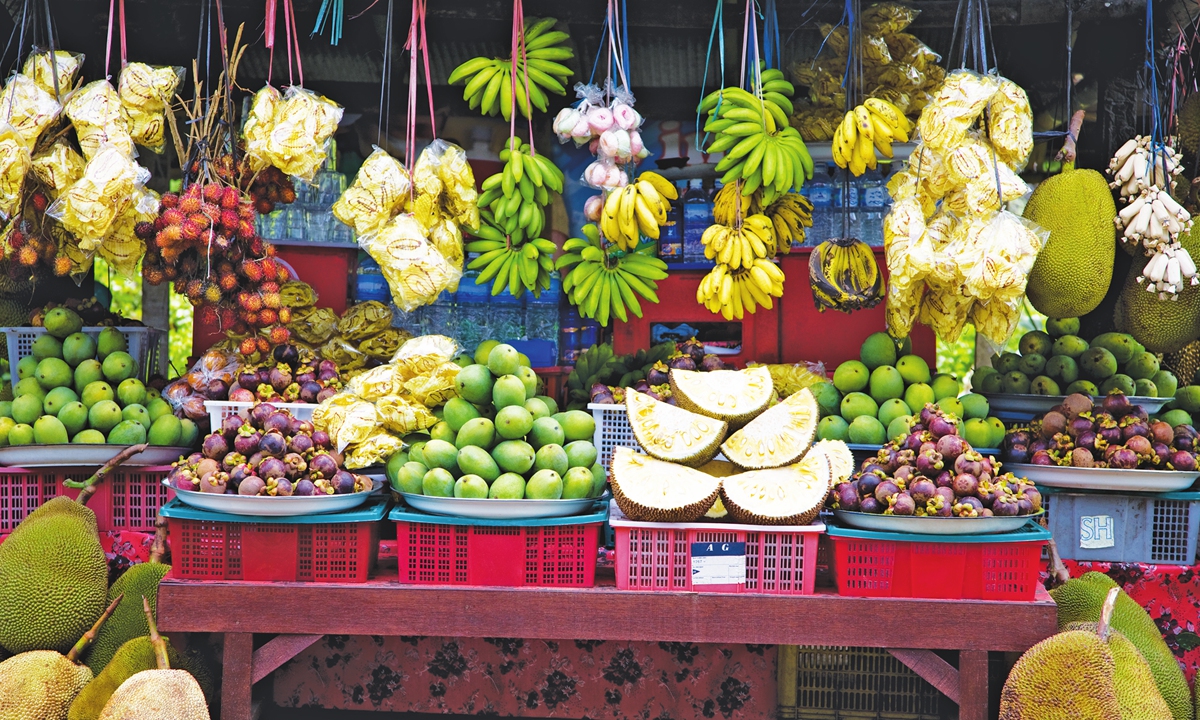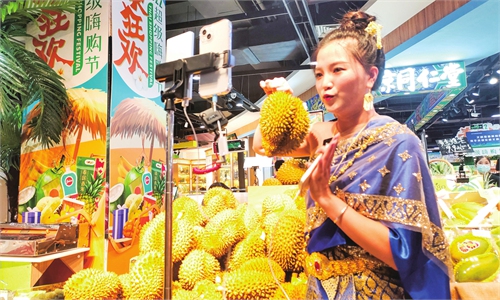S.China’s Guangxi establishes regional fruit exchange centers to facilitate imports from ASEAN countries
Guangxi establishes regional fruit exchange centers to boost trade with ASEAN countries

Photo:VCG
South China's Guangxi Zhuang Autonomous Region has recently announced the establishment of China-ASEAN fruit trading centers in Chongzuo, Nanning and Qinzhou, in a better move of facilitating fruit trade for China with ASEAN countries amid surging demand.
The three exchange centers are under a local project named China-ASEAN Agriculture Products Distribution Center, aiming to further enhance the connection between the autonomous region via land and sea routes with the ASEAN countries, according to a report from China News Service.
The project aims to build a complete trading system that covers fruit distribution, trading and processing, realizing a high level of China-ASEAN fruit trading, display, settlement, warehousing, processing, logistics, and customs clearance, the report said.
Analysts said the establishment of the exchange centers would boost the current fruit import transport network backed by the China-Laos Railway, and will benefit both Chinese consumers and ASEAN's fruit traders with low transport cost.
As a vital phase of China's New International Land-Sea Trade Corridor, Guangxi realized 339.07 billion yuan ($46.50 billion) foreign trade value in the first half of 2023, up 43.2 percent year-on-year, and 161.38 billion yuan of which was made with ASEAN countries, the autonomous region's largest trade partner, jumped by 92,6 percent year-on-year, China Media Group reported in July.
Improved facilitation
The fruit exchange center in Qinzhou is located near the city's port area, which is a part of the China (Guangxi) Pilot Free Trade Zone. The center aims to leverage the unique advantages Qinzhou port possesses in its sea links with ASEAN countries, targeting Malaysian, Cambodian and Thailand's market and bring high-quality tropical fruits such as durian, mango, and longan to Chinese consumers.
During the launch ceremony of the fruit exchange center, first shipment of Malaysian durians arrived in Qinzhou for processing, loading, and then entering a dedicated cold storage facility.
Compared to importing fruits through Friendship Pass, Qinzhou Port has a greater price advantage in terms of ocean shipping. On average, each container can save 10,000 yuan in shipping costs, Zuo Kongtian, a Qinzhou official, told the Global Times.
In the next three years, Qinzhou plans to build a China-ASEAN fruit trading market and online platform, creating a live-stream base for fruit selling, aiming to achieve an annual import and export volume of over 600,000 tons of fruits by 2025.
Qinzhou port has full coverage of 26 ports of ASEAN countries with 36 freight lines, Mai Liang, manager assistant of Qinzhou Development Investment Group, the developer behind Qinzhou port, told the Global Times on Monday.
"Qinzhou is at the south end of China's railway network that can ship imported cargo to all over China," said Mai, adding that local customs commences 24-hour appointment clearance mechanism to secure the efficient operation of the port.
Lan Bin, chairman of Guangxi Qinzhou Xianglong Logistics Co, told the Global Times on Monday that his company has invested about 400 million yuan to start a business in the exchange centers.
"Qinzhou port's geographic advantage can meet strict shipment requirement for some fresh fruits, such as durian and mango, which can save about two days in transportation period," Lan said.
In the first five months of this year, Guangxi's import of fruit from ASEAN reached 3.66 billion yuan, a year-on-year increase of 193.7 percent, according to data released by Nanning customs. With increasing varieties of ASEAN agricultural products were added to China's market, more and more ASEAN fruits are entering the Chinese market.
Guangxi's plan will greatly facilitate imported fruits to be distributed across China, and upgrade business trade structure between China and ASEAN members, Xu Liping, director of the Center for Southeast Asian Studies at the Chinese Academy of Social Sciences, told the Global Times on Monday.
Potential opportunities
As the starting point of China's New International Land-Sea Trade Corridor, Southwest China's Chongqing Municipality also has been building a distribution network for agriculture products imported form ASEAN countries, which will serve to transport them to other regions of China.
Chongqing facilitates the operation of series of land-sea transportation routes along the trade corridor connecting Guangxi, Yunnan Province to multiple ASEAN countries including Laos, Vietnam and Myanmar.
Data from local free trade zone showed that the trade corridor transported 53,000 TEUs, up 20 percent year-on-year in 2022, and the value of the cargo hit 13.5 billion yuan, up 18 percent year-on-year.
ASEAN continues to be China's largest trading partner from January to July, and total trade value between China and ASEAN rose to 3.59 trillion yuan in the first seven months, an increase of 2.8 percent year-on-year, accounting for 15.3 percent of China's total foreign trade, customs data showed.
"Multiple trade fairs and exhibitions held in Guangxi targeting engagement with ASEAN countries provide local market great business opportunities, plus the transport facilitation of the trade corridor starting from Chongqing. Cooperation between China and ASEAN will embrace bright future," Xu said.


